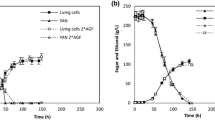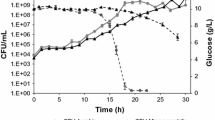Abstract
This paper presents a kinetic study of the dynamics of the population of two Saccharomyces cerevisiae strains (designated K1 and 522D) in mixed culture. These two strains are commonly used in wine making. The K1 strain (killer yeast) secretes a glycoprotein (killer toxin) which causes the death of the 522D strain (sensitive yeast). Initially, the mixed cultures were realized in batch fermentations. Initial concentrations of killer yeast were 5 and 10% of the total population. The influence of the killer strain on the sensitive cultures was measured in comparison with a reference fermentation. The reference fermentation was inoculated only with the sensitive strain. Results show that an initial concentration of 10% of killer strain affects the microbial population balance and the rate of ethanol production. However the fermentation was only slightly disturbed when the proportion of killer to sensitive yeast at the beginning of mixed culture was 5%. To achieve total displacement by the killer yeast at low concentrations, the mixed cultures were carried out in a continuous system. The results obtained in continuous fermentations with the same strains have shown that a level of contamination as low as 0.8% of killer strain was sufficient to completely displace the original sensitive population after 150 h incubation.
Similar content being viewed by others
References
Bevan, E.A. & Makover, M. 1963 The physiological basis of the killer character in yeasts. In Genetics Today vol 1, ed. Geerts, S.J. XIth International Congress on Genetics pp. 202–203. Oxford: Pergamon Press.
Donald Mac, V. 1963 Direct microscopic technique to detect viable cells in pasteurized orange drink. Journal of Food Science 28, 135–139.
Hutchins, K. & Bussey, H. 1983 Cell wall receptor for yeast killer toxin: involvement of b-1-6-D-glucan. Journal of Bacteriology 154, 350–356.
Imamura, T., Kawamoto, M. & Takoaka, Y. 1974 Characteristics of a main mash infected by killer yeast in sake brewing and the nature of its killer factor. Journal of Fermentation Technology 52, 293–299.
Lange, H., Bavouzet, J.M., Taillandier, P. & Delorme, C. 1993 Systematic error and comparison of four methods for assessing the viability of Saccharomyces cerevisiae suspensions. Biotechnology Techniques 7, 223–228.
Maule, A.P. & Thomas, P.D. 1973 Strains of yeast lethal to brewery yeast. Journal of Institute of Brewing 79, 137–141.
Miller, G.L. 1959 Use of dinitrosalicylic acid reagent for determination of reducing sugar. Analytical Chemistry 31, 426–428.
Pfeiffer, P. & Radler, F. 1984 Comparison of the killer toxin of several yeasts and the purification of a toxin of type K2. Archives of Microbiology 137, 357–361.
Philliskirk, G. & Young, T.W. 1975 The occurrence of killer character in yeasts of various genera. Antonie van Leeuwenhoek 41, 147–151.
Ramon-Portugal, F., Délia-Dupuy, M.L., Schneider, G. & Strehaiano, P. 1994 Yeast killer activity: a quantitative study. Biotechnology Techniques 8, 797–804.
Rosini, G. 1983 The occurrence of killer characters in yeasts. Canadian Journal of Microbiology 29, 1462–1464.
Strehaiano, P. 1984 Phénomènes d'inhibition et fermentation alcoolique. Thesis. l'Institut National Polytechnique de Toulouse, France.
Stumm, C., Hermans, J.M., Middeelbeek, E.J., Croes, A.F., De Vries, G.J.M.L. 1977 Killer-sensitive relationship in yeast from natural habitats. Antonie van Leeuwenhoek. 43, 125–128.
van Vuuren, H.J.J. & Jacobs, J. 1992 Killer yeast in the wine industry: A review. American Journal of Enology and Viticulture 43, 119–128.
van Vuuren, H.J.J. & Wingfield, B.D. 1986 Killer yeast-cause of stuck fermentations in a wine cellar. South African Journal of Enology and Viticulture 7, 113–118.
Woods, D.R. & Bevan, E.A. 1968 Studies on the nature of the killer factor produced by Saccharomyces cerevisiae. Journal of General Microbiology 51, 115–126.
Author information
Authors and Affiliations
Rights and permissions
About this article
Cite this article
Ramon-Portugal, F., Delia, M., Strehaiano, P. et al. Mixed culture of killer and sensitive Saccharomyces cerevisiae strains in batch and continuous fermentations. World Journal of Microbiology and Biotechnology 14, 83–87 (1997). https://doi.org/10.1023/A:1008880618359
Issue Date:
DOI: https://doi.org/10.1023/A:1008880618359




